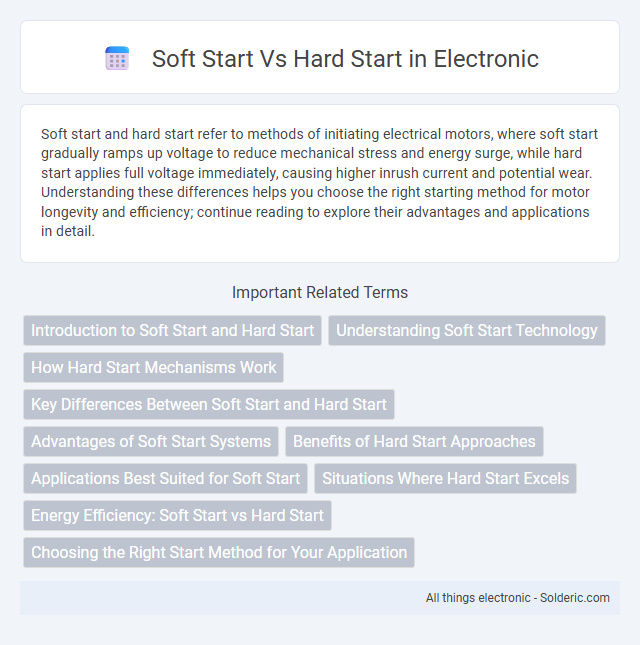Soft start and hard start refer to methods of initiating electrical motors, where soft start gradually ramps up voltage to reduce mechanical stress and energy surge, while hard start applies full voltage immediately, causing higher inrush current and potential wear. Understanding these differences helps you choose the right starting method for motor longevity and efficiency; continue reading to explore their advantages and applications in detail.
Comparison Table
| Feature | Soft Start | Hard Start |
|---|---|---|
| Definition | Gradually ramps up motor current for smooth startup. | Directly applies full power to motor on startup. |
| Starting Current | Low to moderate current, reduces inrush current. | High inrush current, equal to locked rotor current. |
| Motor Stress | Minimal mechanical and electrical stress. | High mechanical and electrical stress. |
| Energy Efficiency | Improves energy efficiency by limiting current spike. | Less energy efficient due to sudden high power draw. |
| Use Cases | Suitable for applications requiring smooth start, like conveyors, pumps. | Used where immediate full torque is necessary, e.g. compressors, heavy loads. |
| Cost | Higher initial cost due to control components. | Lower cost, simple design without controls. |
| Maintenance | May require periodic calibration and monitoring. | Generally lower, but increased wear on motor components. |
| Complexity | More complex electronic or relay control. | Simple wiring, no control electronics. |
Introduction to Soft Start and Hard Start
Soft start and hard start are two common methods used to control the initial power surge in electric motors. Soft start gradually increases voltage to the motor, reducing mechanical stress and electrical peak currents, whereas hard start applies full voltage immediately, causing abrupt torque and higher inrush currents. Understanding these starting techniques is essential for optimizing motor performance, enhancing equipment lifespan, and minimizing electrical disturbances in industrial and commercial applications.
Understanding Soft Start Technology
Soft start technology gradually increases the voltage supply to electric motors, reducing inrush current and mechanical stress during startup. This controlled acceleration minimizes wear on motor components and extends equipment lifespan, enhancing energy efficiency. By contrast, hard start methods apply full voltage instantly, leading to higher startup current and potential damage.
How Hard Start Mechanisms Work
Hard start mechanisms work by using a high starting torque to overcome the initial inertia of heavy loads, enabling motors to reach full speed quickly. These devices often incorporate components such as start capacitors, potential relays, or electronic timers that provide an initial surge of power during startup. This rapid power boost reduces voltage drop and mechanical stress, ensuring efficient and reliable motor operation in demanding applications.
Key Differences Between Soft Start and Hard Start
Soft start motors gradually increase voltage during startup, reducing inrush current and mechanical stress, which enhances equipment lifespan. Hard start motors apply full voltage instantly, causing higher starting current and potential thermal and mechanical strain but faster acceleration. Soft start is preferred in applications sensitive to electrical surges, while hard start suits situations requiring immediate full torque.
Advantages of Soft Start Systems
Soft start systems reduce mechanical stress and electrical surges during motor startup, enhancing equipment longevity and reliability. They improve energy efficiency by gradually increasing voltage, leading to lower inrush current and reduced power consumption. This controlled startup process minimizes wear on electrical components and decreases maintenance costs in industrial applications.
Benefits of Hard Start Approaches
Hard start approaches offer enhanced reliability by ensuring immediate and powerful ignition, reducing the risk of misfires and delays in engine or motor startups. This method provides improved torque and quicker acceleration, which is essential for heavy-load applications and industrial machinery. Your system's overall efficiency and lifespan can increase due to reduced electrical stress during startup, making hard start techniques beneficial for high-demand environments.
Applications Best Suited for Soft Start
Soft start technology is ideal for applications requiring controlled ramp-up of electrical current, such as HVAC systems, pumps, conveyors, and compressors, where minimizing mechanical stress and electrical surges is critical. These devices benefit from reduced wear and tear, extended equipment lifespan, and enhanced energy efficiency during startup. Soft starters are particularly suited for variable load conditions and industrial processes demanding smooth acceleration and deceleration.
Situations Where Hard Start Excels
Hard start motors excel in applications requiring immediate full torque, such as heavy machinery startup, compressors, and pumps with high starting loads. They provide a rapid increase in rotational speed, minimizing slip and improving performance in systems where slow acceleration would cause inefficiency or mechanical stress. Industries like manufacturing and construction commonly rely on hard start for equipment demanding quick, reliable power engagement.
Energy Efficiency: Soft Start vs Hard Start
Soft start motors improve energy efficiency by gradually increasing voltage, reducing inrush current and minimizing mechanical stress on your equipment. Hard start motors draw high surge currents at startup, leading to energy waste and increased wear on electrical components. Choosing a soft start system enhances energy savings and extends the lifespan of motors in industrial applications.
Choosing the Right Start Method for Your Application
Soft start methods gradually increase voltage, reducing inrush current and mechanical stress on motors, making them ideal for sensitive or high-load applications. Hard start techniques apply full voltage immediately, suitable for simple systems where cost and simplicity are prioritized over equipment longevity. Selecting between soft start and hard start depends on factors like motor size, application sensitivity, and the need to minimize electrical and mechanical impact.
soft start vs hard start Infographic

 solderic.com
solderic.com